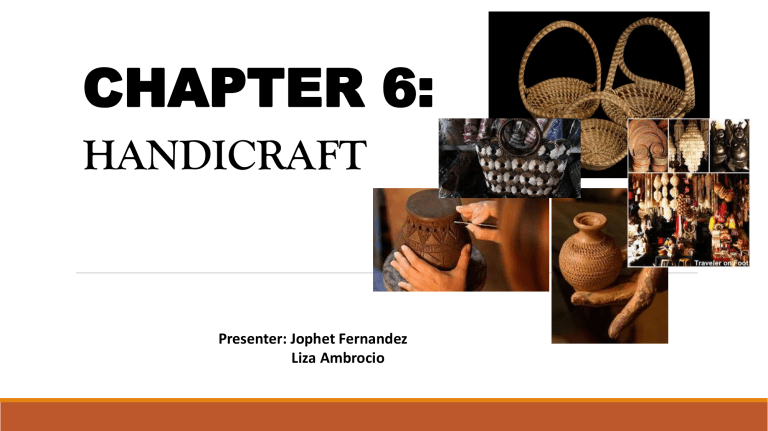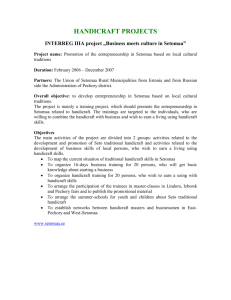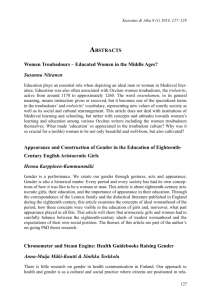
CHAPTER 6: HANDICRAFT Presenter: Jophet Fernandez Liza Ambrocio OBJECTIVES At the end of the lesson, student can: Explain the contribution of handicraft industries to the country’s culture and economy understand awareness on the history of handicrafts in the philippines identify example of handicraft from selected region of the country (philippines) Identify basic elements of handicrafts ` Introduction Philippine economy. Its value both as a product and a skill has been recognized time and again. This has been integrated in the Philippine educational system because of its relationship to arts. According to UNESCO and International Bureau of Education.(Galvante1958), the skill and understanding required by studying art encourage the appreciation of nature, life, production, and art. Moreover, handicraft is also recognized as an important means for aesthetic, intellectual, and moral education. Taking handicraft as part of the curriculum would help students develop self-realization through self-confidence, creative self-expression and communication of one's ideas to others. Students would also learn to respect and value the artistic expression of others within the context of values prevailing in the community. Handicraft A handicraft, sometimes more precisely expressed as artisanal handicraft or handmade, is any of a wide variety of types of work where useful and decorative objects are made completely by one's hand or by using only simple, non-automated related tools like scissors, carving implements, or hooks. Cultural Importance The culture and tradition of our country have also been preserved through the love of handicraft History gives concrete evidence of our rich traditional art, skills and talents as well as the Filipino way of life. HERE SOME EXAMPLE: 1. Tacloban - Tacloban name was said to have been derived from bamboo baskets known as • taklub" or cover. This Utaklub" was created for fishermen to catch fish. crabs or shrimps in shallow areas by hovering a fish and covering it quickly to make a catch. 2. Davao - a similar basket was also used by the Bagobo tribe (Cole, 1913). This is the reason why, in the Social Sciences and in Home Economics subject, these handcrafted materials are included as culture materials to study how the community managed their resources At present, craftsmen and majority of the Filipinos have developed the love for handicraft products by showcasing them not only in museums but by also using them in their everyday life. Economic Importance Handicraft is a great contributor to the economic development of the Philippines through job creation and employment A huge number of artisans and employees are hired by handicraft industries. Even with low capital investments, handicraft products are now part of the international market which bring additional income to the country. Handicraft in the Philippines: A Brief History Handicraft in the Philippines is almost 5000 years old. In the Philippines some evidence of early Filipinos craftsmanship have been discovered in caves and in the burial places of ancient Philippine tribes before the Spanish Colonid period (Galvante, Udan, & Salvador, 1958). Some of these relics were tie 29 earthenware secondary burial pots called the Maitum jars, named after Ayub Cave in Maitum, Saranggani Province where these jars were found. The report said that these jars were "anthropomorphic", meaning human-shaped the jars have head-shaped covers which depict varied facial expressions Handicraft flourished especially as religious items during the Spanish colonial period. The more prominent handicrafts known were the sculpture, woodcarving, metal craft, embroidery, and weaving. The Philippines was known for embroidery such as Calado, which was applied to clothes and undergarments. The Banton cloth in Banton, Romblon, woven from red, black, and white abaca threads is also known as the oldest relic estimated to be 400 years old during the time of Spanish occupation. The introduction of handiwork or skills in the primary curriculum paved the way to the growth of handicraft in the country during the American occupation. The teaching of handicraft was taught differentiated by gender. Carpentry was taught for boys while the embroidery such as Ca-lado was for the girls. Such development gave the local designs and indigenous handicraft to flour-ish and export of these products was made possible. The existing free trade agreement with the United States has given way for the export of Marikina shoes, buntal and Baliwag hats, and other embroidered products. Indigenous Philippine Arts and Crafts Weaving is the most precious traditional livelihood that originated in tie pre-colonial times and is still kept until today. The art of weaving of me Cordillera tribal groups in the northern part of the country is still existing despite the threat of the more practical, mass production of cloth. The natives used backstrap loom to produce blankets and articles of clothing (The Freeman, 2016). In the entire province of Antique, Pinya cloth has also been produced in looms.It is a delicate and leaves exquisite of pineapple hand-woven plants. cloth The Barong that is made Tagalog from is the pers obtained popular product from made from this organic and airy textile of pinya fiber. Abaca fiber is pro-duced from the abaca plant which is grown in some places. Eastern Visayas is the largest supplier of this product followed by Bicol region. Pinya cloth Handicrafts from Selected Regions Almost every region in the Philippines has its own "specialty" products or unique process. Examples of traditional handicrafts from selected regions are discussed in the succeeding paragraph. 1. Loom Weaving — Cordillera Administrative Region Some of the tribes in the Cordillera have their unique weaving techniques. In Abra, there are three known types of weaving techniques namely: Loom Weaving • Pinilian - weaving features designs common to the locality • Binakol - features uniform geometric patterns that depict the waves of sea. • Tiniri- it uses "twisted weaving technique 2. Calado — Lumban, Laguna, and Taal, Batangas Calado is a type of embroidery using a process of pulling threads from certain areas of a cloth, usually pinya or jusi, then sewing the drawn threads using various stitches to form clean holes on the cloth The final process entails embroidery to create designs that am smooth, evenly stitched and With an embossed quality to give depth and volume.A 3. Marble Craft- Romblon Romblon marble is known to have qualities with commercial value that can rival those of other countries like Italy. The famous mortar and pestle which are used in the kitchen are the earliest prod-ucts carved out of marble. Three Basic Elements of Handicraft 1. Design. This refers to an idea or an arrangement scheme that is shown or exhibited into a configuration, drawing, model, mold. pattern plan or specification to work out the form of an object Once the design is drawn by the artisan or designer, the expected finished shall be visualized with the given perspective. 2. Material. This is the most important element of handicraft which is used as input to a production pro-cess for subsequent transformation into the finished product. This could either be natural, modified or in its semiprocessed state. 3. Technique. This refers to the method and process on how the material is to be handled. The tools and equipment to be used will determine the technique to be applied in the production stage.

